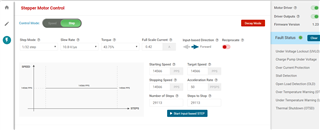Tool/software:

This thread has been locked.
If you have a related question, please click the "Ask a related question" button in the top right corner. The newly created question will be automatically linked to this question.
Tool/software:

Hi Alex,
This is probably due to current chopping of the regulation in STRC (ripple control decay) combined with stopping the stepper motor in a microstep position where a physical pole of rotor and stator may not exist. The reason is STRC uses slow decay most of the time, and when the motor is stopped with low current amplitudes of the microsteps slow decay may not be sufficient to keep the current regulated at that level - you could observe this using a current probe in the oscilloscope. STDD (dynamic decay) would use fast decay combined with slow decay and would be able to keep the regulation tight at these low current amplitudes.
When you change the torque DAC the STRC may lock to the regulation or perhaps the motor shaft may move slightly to align with the poles. A potential solution could be to switch over to STDD just before stopping the motor. This behavior is also specific to some stepper motors.
Regards, Murugavel
Hi Murugavel,
Got it, your explanation is great.
There's another strange issue: When the motor stops, I often turn off the driver output by controlling DRVOFF pin, then when the driver output is enabled again, I often hear a click-click sound. Is this issue related to uncertain location, as you mentioned in the above "combined with stopping the stepper motor in a microstep position where a physical pole of rotor and stator may not exist"?
Is there any other way to avoid this issue, when retaining to disable DRVOFF pin after the motor stops?
Thanks,
Alex
Hi Alex,
There's another strange issue: When the motor stops, I often turn off the driver output by controlling DRVOFF pin, then when the driver output is enabled again, I often hear a click-click sound. Is this issue related to uncertain location, as you mentioned in the above "combined with stopping the stepper motor in a microstep position where a physical pole of rotor and stator may not exist
Yes this is correct.
Is there any other way to avoid this issue, when retaining to disable DRVOFF pin after the motor stops?
If you keep track of the indexer position in the MCU and ensure you stop at physical pole alignment positions this can be mitigated. Usually this would be full-step positions - electrical angle 45, 135, 225 and 315 degrees.
Regards, Murugavel